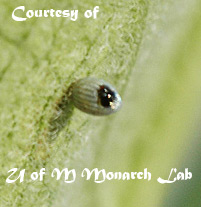Incredible, Edible, Monarch Butterfly Eggs
Monarch butterfly eggs are the first of four butterfly stages that make up the monarch butterfly metamorphosis. The duration of this first stage is 4-7 days making this the shortest of the four stages of a butterfly. (Colder weather accounts for slower hatching times.)
The egg can be easily missed by the naked eye at roughly 1.2 millimeters long or 1/32 inches. The whitish egg is spherical in shape and has vertical ridges.


Eggs can be found on various species of milkweed including common milkweed(pictured above), prairie milkweed, and the bloodflower.
The female generally lays her eggs on bottoms of leaves, but she's been known to get high marks for creative egg laying.
For those interested in raising monarchs from tiny eggs, it is very important to have a fresh supply of milkweed available or your caterpillar will crawl off to that big milkweed patch in the sky.
In nature, it is widely estimated that less than 10% of monarchs survive to reach adulthood. Many monarch butterfly eggs are eaten by predators including ants and spiders.
The next three stages of the monarch butterfly metamorphosis are:- monarch caterpillar
- monarch chrysalis
- monarch butterfly
Raising Monarchs from Eggs
Before you can start raising monarch butterflies, your first task is to hunt down a monarch butterfly egg. Monarch females generally lay their eggs on the undersides of milkweed leaves as seen in this butterfly video: Laying Low
Laying Low
Keep in mind they prefer fresh baby leaves, like the female pictured to the right.
This is why it's a good idea to pull unwanted small milkweed plants from your lawn or you could be mowing down dozens of monarch eggs!
I've been "trapped" into raising more monarchs than I planned on because I wasn't regularly weeding out these baby lawn milkweed. Now, I make sure to check the lawn every other day during the spring/summer months. As you can tell from the photo, they have no issue with laying eggs at ground level!
If you can't find eggs on local milkweed plants, you always have the option of buying a monarch butterfly kit complete with egg(s). Just make sure you don't purchase more than you can handle. I'd suggest buying no more than 1-2 eggs for each milkweed plant you have access to.
Also, think about your cage space when raising monarch butterflies...or more specifically, the caterpillars. For the caterpillar cage
After you find/purchase your egg take a spray bottle and wet down the milkweed leaf so it doesn't dry out. Place the leaf in a small bowl and make sure there is no standing water. Repeat this process twice a day to insure egg survival.
 Eating Out
Eating Out
Congrats, you've raised a monarch butterfly...egg that is! Your adventure's about to get a bit more interesting with the emergence of your monarch caterpillar.
They're Back!
Monarch season is in full sWing and they've been sighted across even the northern most states and up into the land of Celine Dion.
A superior way to experience butterflies up close is to raise them yourself.
Check out the links below to discover how you can help guide them through a magical month of metamorphosis.
Disclosure
ButterfliesonFlowers.com is my personal site. It accepts advertising and other forms of compensation but does not accept compensation to influence reviews of site products or services.
The information on this comes from our opinions, research, and experiences. Click here for more about advertising and disclosures.






